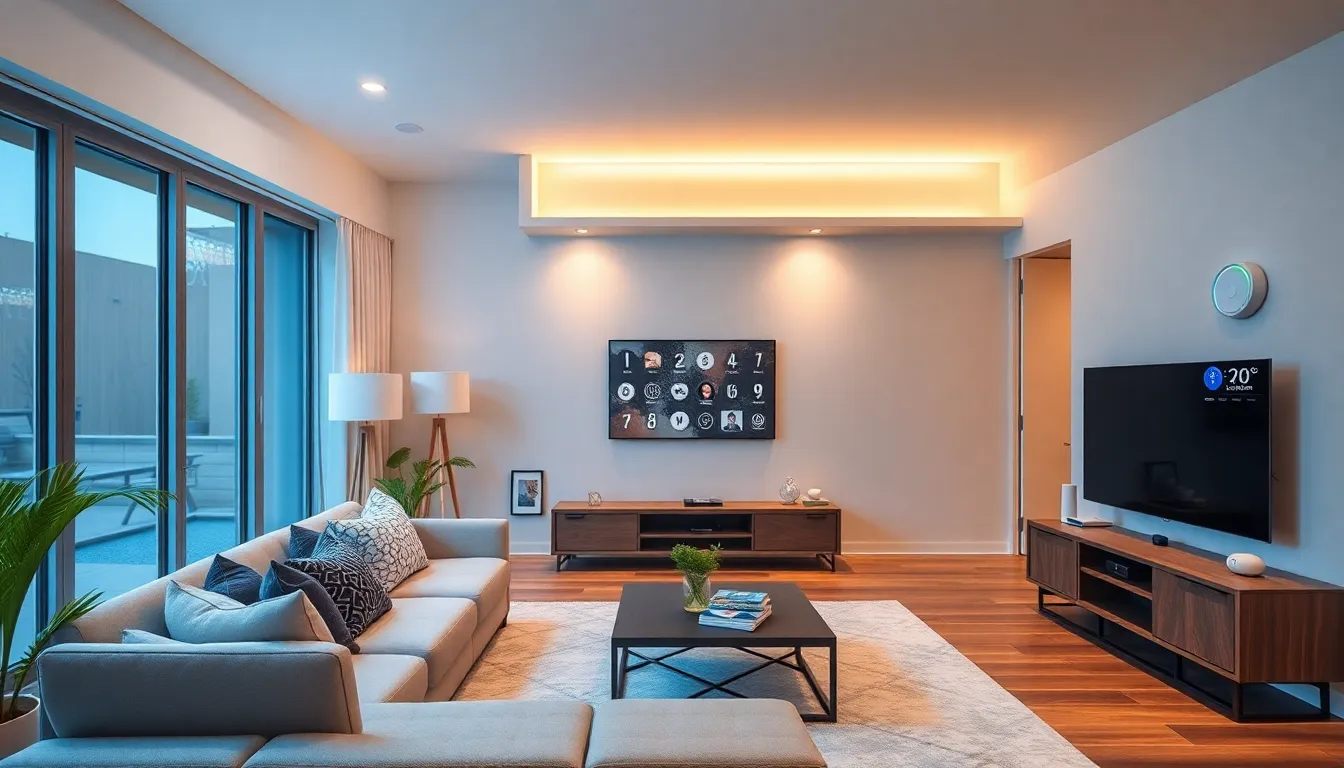Table of Contents
ToggleHome automation technology is transforming the way people interact with their living spaces. With smart devices becoming more accessible, homeowners can now control everything from lighting and security to temperature and entertainment systems with just a tap on their smartphones. This shift not only enhances convenience but also offers increased energy efficiency and security.
As technology continues to evolve, the possibilities for home automation are expanding rapidly. Integrating artificial intelligence and machine learning into everyday devices allows for a more personalized and intuitive experience. Homeowners can create customized environments that adapt to their lifestyles, making their homes not just smarter but also more comfortable. Whether someone is a tech enthusiast or just looking to simplify daily tasks, home automation presents a compelling solution for modern living.
Overview of Home Automation Technology
Home automation technology revolutionizes interactions within living spaces, offering smart solutions for enhanced comfort and efficiency. This technology enables homeowners to manage functions like lighting, security, and temperature through interconnected devices.
Definition and Purpose
Home automation refers to the integration of technology and appliances in a residential setting that provides automated control over various systems. The primary purpose of home automation is to improve convenience, increase energy efficiency, and enhance home security. With smart devices connected to the internet, homeowners gain the ability to control and monitor their environments remotely, simplifying daily tasks and providing peace of mind.
Brief History and Evolution
Home automation technology traces its roots back to the 1960s with the introduction of control systems for heating and lighting. Innovations like the X10 standard in the 1970s allowed electrical devices to communicate over power lines. The advent of the internet in the 1990s marked a significant turning point, enabling remote control of smart appliances. Over the years, advancements in wireless technologies, such as Wi-Fi and Bluetooth, have fostered an ecosystem of interconnected devices. The emergence of artificial intelligence and machine learning has further propelled the evolution, allowing for intuitive, personalized experiences that adapt to individual preferences. Today, home automation encompasses a wide array of devices, including smart thermostats, security cameras, and voice-activated assistants, shaping modern living for diverse homeowners.
Types of Home Automation Systems

Home automation systems offer various solutions for enhancing the convenience, security, and efficiency of residential environments. The primary types include lighting control, security automation, and climate control systems.
Lighting Control Systems
Lighting control systems allow homeowners to manage their lighting remotely or automatically. Key features include:
- Smart Bulbs: Smart bulbs provide adjustable brightness and color changes, controllable via apps or voice.
- Dimmer Switches: Dimmer switches enable users to set preferred lighting levels for different activities or moods.
- Motion Sensors: Motion sensors automatically turn lights on when someone enters a room and off when they leave.
- Timers: Timers schedule lights to turn on or off at specific times, enhancing security by simulating occupancy.
Security Automation
Security automation systems enhance safety and peace of mind within the home. Notable components include:
- Security Cameras: Security cameras offer real-time monitoring and recording, accessible through smartphones.
- Smart Locks: Smart locks provide keyless entry options, allowing remote locking or unlocking.
- Alarm Systems: Alarm systems integrate sensors to detect unauthorized access and alert homeowners via notifications.
- Motion Detectors: Motion detectors trigger alerts or activate cameras when movement occurs in designated areas.
Climate Control Systems
- Smart Thermostats: Smart thermostats learn users’ schedules, automatically adjusting temperatures to increase efficiency.
- Zoning Systems: Zoning systems allow different areas of the home to be heated or cooled independently, maximizing comfort.
- Humidity Sensors: Humidity sensors monitor moisture levels, activating dehumidifiers or humidifiers to maintain ideal conditions.
- Remote Control: Remote control enables adjustments to thermostat settings from anywhere, enhancing convenience.
Benefits of Home Automation Technology
Home automation technology offers numerous advantages that improve the functionality and security of residential spaces. These benefits include improved energy efficiency, enhanced security features, and increased convenience and comfort.
Improved Energy Efficiency
Home automation systems promote energy efficiency through smart devices that optimize energy use. Smart thermostats adjust heating and cooling based on occupancy and preferences, saving up to 30% on energy bills. Automated lighting systems turn off lights in unoccupied rooms, further reducing electricity consumption. Schedule-based controls enable homeowners to manage energy usage, such as pre-programming devices to operate during off-peak hours, leading to additional savings.
Enhanced Security Features
Home automation enhances home security with integrated smart systems. Security cameras provide real-time monitoring and alerts for suspicious activity. Smart locks enable remote locking and unlocking, eliminating the worry of lost keys. Alarm systems trigger notifications on smartphones, ensuring prompt responses to potential threats. Motion sensors activate lights when movement is detected, deterring intruders and providing peace of mind.
Increased Convenience and Comfort
Home automation simplifies daily routines through convenience-driven technology. Homeowners can control lighting, temperature, and security settings with voice commands or mobile apps. Automated routines allow systems to synchronize; for example, lights can dim, and the thermostat can adjust as users watch a movie. Smart appliances further enhance comfort by providing tailored functionality, such as refrigerators that manage groceries and ovens that can be preheated remotely.
Challenges and Considerations
Home automation technology presents several challenges that homeowners must consider. These challenges include privacy and security risks, compatibility issues, and an evaluation of initial costs versus long-term savings.
Privacy and Security Risks
Privacy and security risks pose significant concerns with smart home devices. Many devices collect personal data, including usage patterns and preferences, which could be vulnerable to hacking. According to recent studies, over 50% of smart home devices featured vulnerabilities that cybercriminals could exploit. Users often lack adequate security features, making it essential for homeowners to implement strong passwords and secure home networks. Regular software updates and device monitoring further minimize these risks, enhancing the overall security of home automation systems.
Compatibility Issues
Compatibility issues emerge when integrating various smart home devices. Different manufacturers often use distinct protocols and standards, leading to challenges in creating a cohesive system. Homeowners may face difficulties when attempting to control devices from multiple brands through a single interface, limiting functionality. Selecting devices that support widely used standards, such as Zigbee or Z-Wave, fosters interoperability and smoother integration. Researching compatibility before purchasing devices can prevent potential integration headaches.
Initial Costs vs. Long-Term Savings
Evaluating initial costs versus long-term savings becomes crucial when considering home automation investments. While smart devices may carry higher upfront prices, their energy efficiency can lead to substantial savings over time. For example, smart thermostats typically save homeowners 10-30% on heating and cooling bills, while smart lighting can reduce electricity usage significantly. Homeowners should analyze potential savings against installation and equipment costs to determine the financial viability of home automation. Understanding the return on investment is vital for making informed decisions.
Future Trends in Home Automation Technology
Home automation technology continues to evolve, driven by innovations that enhance user experience and efficiency. Notable trends include the integration of artificial intelligence (AI) and machine learning, as well as the expansion of smart devices in residential settings.
Integration with AI and Machine Learning
Integration with AI and machine learning significantly enhances home automation systems. These technologies enable devices to learn homeowner preferences and routines, leading to a more personalized experience. For instance, smart thermostats utilize AI to analyze usage patterns, adapting temperature settings automatically. Voice-activated assistants, powered by machine learning, recognize and respond to specific commands, making interactions more intuitive. Predictive analytics can optimize energy consumption by adjusting settings based on anticipated weather changes, enhancing energy efficiency and comfort.
Expansion of Smart Devices in Homes
Expansion of smart devices in homes accelerates the growth of home automation technology. Homeowners increasingly adopt various devices, including smart refrigerators, automated window treatments, and even connected appliances like washing machines. This proliferation enhances system interoperability, allowing different devices to communicate seamlessly. Integration with home networks simplifies control through smartphones and centralized apps. Smart energy management systems also provide homeowners with real-time insights into their energy usage, enabling informed decisions for reducing consumption and costs. Overall, the increased presence of smart devices facilitates a more interconnected living environment.
Home automation technology is revolutionizing how people manage their homes. With smart devices at their fingertips homeowners can enjoy unparalleled convenience and enhanced security. The integration of AI and machine learning is pushing these technologies further making them smarter and more intuitive.
As homeowners embrace this shift they can experience significant energy savings and improved comfort. While challenges like privacy concerns and compatibility issues exist the benefits often outweigh the drawbacks. The future of home automation looks promising with ongoing innovations set to enhance user experiences.
Ultimately home automation is not just a trend but a valuable investment in modern living. It simplifies daily tasks while providing peace of mind and efficiency for households everywhere.


